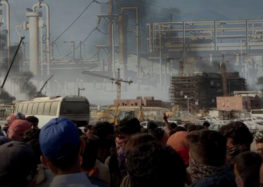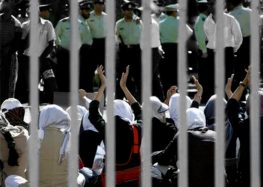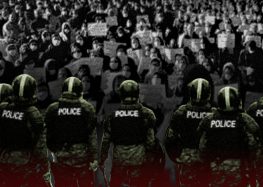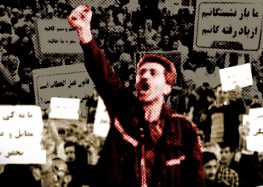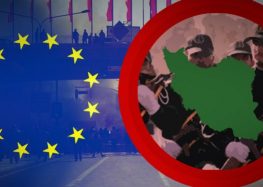The Khomeini Period (1979–1989)
A Growing Crisis: The Impact of Sanctions and Regime Policies on Iranians’ Economic and Social Rights
The Khomeini Period (1979-1989)
During the time that Ayatollah Khomeini was ruling Iran, sanctions against the Islamic Republic were essentially unilateral, imposed solely by the US. Even at the height of the hostage crisis, which ensued in the wake of the seizure of the American embassy in Tehran and the holding of its personnel hostage by Iranian students for 444 days, American allies and partners refrained from emulating the US’s example of sanctioning Iran. To the contrary and to the chagrin of Washington, they generally filled the void that had been left by America’s withdrawal from trade with the Islamic Republic.
Between 1979 and 1980, in response to the hostage crisis, President Carter issued one proclamation and three executive orders against Iran. Proclamation 4702 banned the import of Iranian oil into the US. Executive Orders 12170, 12205, and 12211, respectively, froze all assets owned by the government and the central bank of Iran in the US, prohibited American exports to Iran, and forbade the conduct of financial transactions on the part of American citizens with, as well as traveling to, Iran. All of the above restrictions, however, except for the freezing of Iranian assets in the US, were annulled by the US after the release of American hostages in 1981.[13]
In 1984 the Reagan administration designated Iran a state sponsor of international terrorism following the bombing of the US marine barracks in Lebanon, which made Iran ineligible for American financial assistance (with the exception of the provision of disaster relief). In 1986, the US Congress passed, and President Reagan signed, the US Arms Export Control Act, on the basis of which the sale of American weapons and spare parts to Iran became illegal. In 1987, the president issued Executive Order 12613, banning the import of all Iranian products, including Iranian crude oil, into the US. Finally, in 1988, President Reagan ordered American directors at international lending institutions such as the IMF and the World Bank, where America’s sway is quite strong, to refrain from agreeing to the issuance of loans to Iran.[14]
Although these moves imposed costs on the Iranian economy, their impact was limited. Among the sanctions that the US imposed during the Khomeini period, the freezing of Iran’s assets in the US, which amounted to some $12 billion, caused the greatest harm to Iran, as the Islamic Republic was in need of these funds to pay for the prosecution of its war with Iraq. However, during this time Iran was still able to sell its oil, the mainstay of its economy, to non-American buyers. Actually, even after being banned from importing Iranian oil into the US, American oil companies continued to purchase oil from Iran for resale to non-American entities. Iran, meanwhile, was able to buy some of its requisite American weaponry and spare parts from Israel instead of the US. Moreover, even the US itself, in violation of its own laws, sold weapons to Iran during the Iran-Contra episode.[15] At the same time, Iran was able to continue to import US-made goods through Dubai at slightly higher prices and, wherever possible, switched to non-American (at the time mostly European, especially German) sources. Lastly, Iran did not seek to borrow money from international lending institutions during the Khomeini period, rendering this American prohibition inconsequential.[16]
At the external level, during the 1980s the Iran-Iraq war and reductions in the price of oil had a far greater effect on the Iranian economy than American sanctions. Indeed, damages inflicted on Iranian civilian and petroleum infrastructure by the Iraqi war machine in the 1980s ran into hundreds of billions of dollars, and the fall in the price of oil from close to $40 per barrel in 1981 to near $10 per barrel by 1986 hugely reduced Iran’s export revenues. In contrast, the price that Iran was made to pay because of the American sanctions was approximately $1 billion per annum.[17]
These costs, however, pale in comparison with the internal burdens that were placed on the Iranian economy during the Khomeini period. The transformations that were unleashed between 1979 and 1989 in Iran resulted in the institutionalization of exceedingly damaging economic and social structures.
While Ayatollah Khomeini and his associates inherited a largely oil-dependent economy with a relatively inefficient manufacturing sector from the Shah’s regime, the policies they implemented during the first decade of the revolution laid the groundwork for the entrenchment of a far more inefficient and oil-dependent system—saddled with a much larger and incompetent bureaucracy. This system has come to perpetuate consistently high rates of unemployment, inflation, and venality as well as anemic rates of growth, which have, in turn, been inimical to the economic welfare of the Iranian people. At the same time, the policies implemented during the first decade after the revolution to promote child bearing helped to unleash a population explosion which, in the face of the country’s poor economic growth, has proved disastrous for the economic well-being of Iranian citizens, particularly the youth.
Largely swayed by developmental models that emphasized the non-capitalist path to economic progress, the framers of Iran’s post-revolutionary constitution enshrined the principle of state domination and control of the economy in Article 44 of their new constitution. This article enjoins the state to control “all large-scale and mother industries, foreign trade, major minerals, banking, insurance, power generation, dams and large-scale irrigation networks, radio and television, post, telegraph, and telephone services, aviation, shipping, roads, railroads, and the like.” The implementation of Article 44, along with the decision to expropriate and nationalize the assets of those industrialists who had been close to the Shah’s regime, caused state and quasi-state organizations to exert control over what is estimated to be 70 to 80 percent of the Iranian economy.[18] The bonyads, opaque, state-controlled “charitable organizations” formed from expropriated private assets during these years, came to control as much as 30 percent of the Iranian economy, furthering the state domination of the economy.[19]
Iran’s unemployment problem, meanwhile, is in part the result of its overwhelmingly young demographic profile. Between 1979 and 1989, the Islamic Republic experienced a population explosion. During these years, the annual population growth rate hovered around four percent. This youth bulge has since served as an internal drag on the advancement of the economic and social rights of Iranians, 70 percent of whom are presently under the age of 35. In large part because of the regime’s pro-natal policies from 1979 to 1989,[20] roughly 20 million babies were born in Iran in the first ten years after the revolution.
Iran’s highly restrictive labor laws, enacted during the Khomeini years, also served to undermine the ability of Iranians to fulfill their right to gainful employment. Although intended to expand workers’ rights and job security, the labor code’s draconian prohibitions against the elimination of redundancies through lay-offs only succeeded in exacerbating unemployment. Fearful of getting stuck with their employees, existing businesses were confronted with an additional disincentive against expansion, and would-be entrepreneurs were cautious about starting new businesses and hiring workers on a permanent basis. To circumvent the labor law’s restrictive prohibitions, which applied only to permanent employees, most employers took to hiring contract workers, who could be summarily dismissed. The law thereby subsequently harmed both job creation and security.
By way of partially compensating for its economic deficiencies, attracting public support, and dealing with the exigencies of the Iran-Iraq war, the Islamic Republic instituted a highly inefficient universal subsidy system during this period, covering all basic food items as well as kerosene, diesel, natural gas, and gasoline. Until Ahmadinejad initiated his subsidy rationalization program in December 2010, these subsidies, particularly the ones on energy, consumed, depending on the year and the price of oil, between 10 and 30 percent of the nation’s annual GDP, a figure far more costly than the burdens imposed by sanctions during this period. Moreover, the energy subsidies, which consumed by far the largest share of the allocations devoted to the program, primarily benefited the affluent who, depending upon the year, were favored by a ratio of about 12:1.[21]
On the more positive side, the first decade of the revolution also witnessed the laying of the foundations for improving the social conditions of Iranians, enabling them to further their rights to education and healthcare. In spite of the sanctions, infant mortality, life expectancy, access to healthcare, the number of physicians and nurses per capita, clean water, immunization, and access to education all registered significant improvements. The greatest strides in literacy and education were made by women and youths, while conditions in the countryside (where a large fraction of the devoted social base of the regime resides) were improved substantially. The rate of poverty, according to the World Bank, eventually dropped from 40 percent to 20 percent.[22] Families from the traditional strata of society, who had been reluctant to allow their daughters to attend the Shah’s secular schools, relented, and the stage was set for females to eventually replace males as the more numerous entrants and graduates from the nation’s expanding institutions of higher learning.
In sum, the essential features of the economy of the Islamic Republic, which were put into place and became entrenched during the first decade of the revolution, were far more detrimental than sanctions in detracting from the capacity of Iranians to attain their economic rights to gainful employment as well as affordable food and shelter in the 1980s. This pattern would be replicated in the 1990s and 2000s, since the structure of the Iranian economy that took shape in the 1980s was not appreciably altered.
[13] Richard Sabatini, “Economic Sanctions: Pressuring Iran’s Nuclear Program,” NTI, June 24, 2010. See also Suzanne Maloney, “Sanctioning Iran: If Only It Were So Simple,” Washington Quarterly, January 2010, p. 138.
[14] Sabatini, “Economic Sanctions: Pressuring Iran’s Nuclear Program,” 2010.
[15] See Trita Parsi, Treacherous Alliance: The Secret Dealings Israel, Iran, and the United States, New Haven: Yale University Press, 2007.
[16] See Hossein Askari, John J. Forrer, Hildy Teegen, and Jiawen Yang, “US Economic Sanctions: Lessons From the Iranian Experience,” Global Management Working Paper Series, The George Washington University, July 2001.
[17] Ibid. See also Hossein Askari, “Iran’s Economic Policy Dilemma,” International Journal, Vol. 59, No. 3, Summer 2004, pp. 659, 660.
[18] See Jahangir Amuzegar, “Iran’s 20 Year Economic Perspective: Promises and Pitfalls,” 2009.
[19] Hossein Askari, “Iran’s Economic Policy Dilemma,” 2004.
[20] On the adoption and subsequent reversal of pro-natal policies in Iran during the first decade after the revolution, see Homa Hoodfar, “Devices and Desires: Population Policy and Gender Roles in the Islamic Republic,” Middle East Report, September-October 1994. See also Homa Hoodfar and Samad Assadpour, “The Politics of Population Policy in the Islamic Republic of Iran,” Studies in Family Planning, Vol. 31, No. 1, March 2000. Ayatollah Seyyed Ali Khamenei, the Supreme Leader of Iran, has recently lamented this reversal, along with his own role in it, enjoining the government to start the process of nullifying family planning. Fearing the consequences of a graying population, the supreme leader has again called on the people to go forward, be fruitful, and multiply. See “Khamenei on Population Control: ‘May God and History Forgive Us,’” Al-Monitor, October 10, 2012. According to the Iranian daily Maghreb, both Ayatollah Khamenei and President Ahmadinejad have emphasized the necessity of expanding the population of the country to 120-200 million individuals. See “Reaction of the Health Minister to the Prohibition on the Sale of Contraceptives,” Maghreb, October 18, 2012.
[21] Askari, “Iran’s Economic Policy Dilemma,” 2004, p. 662.
[22] Ibid, pp. 656-657.


